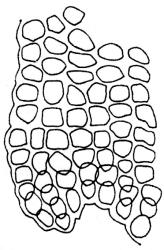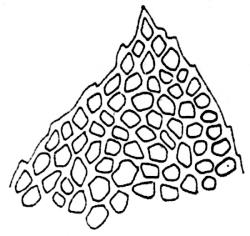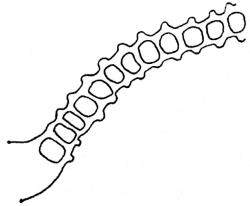Plants small and slender, dull, rigid, green or brown-green, forming loose mats on coastal rocks. Stems short, mostly 5–8 mm, irregularly branched, in cross-section of thick-walled cells throughout, lacking both a hyaloderm and a central strand. Stem and branch leaves not differentiated, crowded, evenly spaced in spiral ranks, erect and imbricate when dry, spreading when moist, broadly ovate, mostly 0.45–0.55 × 0.2–0.25 mm, broadly acute or obtuse, neither decurrent nor fragile, entire or weakly crenulate, plane at margins, in cross-section broadly V-shaped; mid laminal cells rounded-quadrate, 7–9(–12) µm, firm-walled, strongly mammillose on both surfaces; juxtacostal cells not differentiated; basal marginal cells ± oblate in few to several rows, not forming a distinct alar group. Costa stout, ending below the leaf apex but the terminus often ill-defined, protruding weakly on abaxial surface, both the abaxial and adaxial cells elongate, in cross-section composed of uniform, stereid-like cells. Paraphyllia and pseudoparaphyllia lacking. Propagula (branchlets) present in axils of upper leaves.
Sex organs and sporophytes not known.
Lindbergia maritima is most likely to be confused with the regionally widespread Pseudoleskea imbricata, which it resembles in some macroscopic features. However, L. maritima is more irregularly branched (especially in the terminal branches) than P. imbricata and the latter also lacks axillary propagula. The strongly and centrally mammillose rounded-quadrate mid laminal cells of Lindbergia maritima differ strikingly from the more elongate and inconspicuously prorate cells that are a feature of P. imbricata.
Lindbergia maritima could also be confused with the more widespread (and also coastal) Haplohymenium pseudotriste (placed here in the Anomodontaceae), but a number of features differentiate these taxa: Lindbergia maritima is a more robust plant with leaves more ovate than the ± lingulate leaves of H. pseudotriste. The costa in L. maritima is less obscure and longer and the laminal cells are mammillose (vs pluripapillose in H. pseudotriste). Also, the axillary propagula seen in L. maritima are not found in Haplohymenium. Lindbergia maritima also lacks ventral fascicles of rhizoids, which are a feature of H. pseudotriste. Lindbergia is epilithic in N.Z. while Haplohymenium is almost exclusively epiphytic.
NI: N Auckland (Waitakere Ranges coast).
Endemic.
Known only from the type locality on coastal andesite pebble breccia outcrops and boulders. This species has not been found at any other locality since it was collected and described by the visiting Danish bryologist Jette Lewinsky in 1977.
Shore-line searches of accessible parts of the Waitakere coast from Whatipū to Anawhata, including the seaward side of Lion Rock, have been made. In 2007 a targeted search (totalling 16 people-hours) was made by Auckland Regional Council staff, trained to recognise the moss, and using abseiling gear to access suitable outcrops at or near the type locality. This also failed to locate any additional populations of L. maritima.
The moss has been periodically monitored at the type locality, where it is vulnerable to intensive storm wave action. The best evidence available suggests that this species is in danger of extinction, and is listed as a "nationally critical" threatened species by Rolfe et al. (2016).
While noting that Lindbergia is a genus of epiphytes in other parts of its range, no alternative generic placement for L. maritima can be suggested here.














